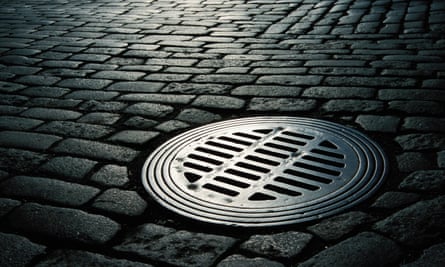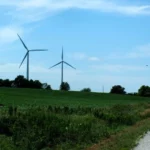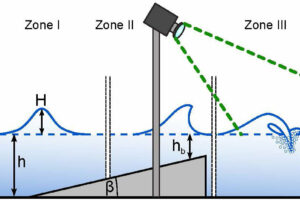Ionce lived in a building where every morning the double flush of the upstairs neighbour’s toilet trip reverberated loudly through our kitchen. Now, instead of being a source of heated neighbourly relations, Dutch sewage waste is being seen as a reliable heat source for millions of homes that the government wants to be unhooked from the country’s gas system by 2050.
Lieven de Key, a housing corporation in Amsterdam, is planning what is believed to be the first sewer warmth project that will tap into a main district sewage pipe to warm 1,600 existing social and student homes. After the Dutch words for sewer, riool, and warmth, this sustainable, 24/7, year round heat source is dubbed riothermie.
After some initial scepticism, the company was slowly won round to the idea of urban heating, says development manager Rienk Postuma. They talked to a company called Liander, which builds underground connections, and to the water board, “and then the idea was born to put water-fuelled heat pumps in the buildings, winning back heat from the collective sewer for this part of Amsterdam”.
“We have a photo of the street covered with snow, and the manhole covers all without snow,” says Jeroen Rademaker, the project leader. “Even when there’s snow in the winter, the sewer is warm. Warm sewage water flows 24 hours a day and we should capture it. This can happen wherever there is a big sewage pipe.”
“The warmth comes from showers, the toilet, wastewater from washing, from the dishwasher, from the washing machine,” says Postuma. “Together it all gives, throughout the year, a temperature between 15 and 18 degrees. And we are going to make a bypass around the main sewer, put a heat exchanger around it and bring it to the houses in insulated pipes. We place it in an electric heat pump, and the water is heated up to 60 or 70C – medium temperature.”
The heat exchanger transfers that source heat from the drain to a working fluid that can be transported to the buildings without needing to circulate the actual sewage waste. Then the blocks’ heat pumps, fired by solar energy, can amplify that heat in the opposite way to the workings of a refrigerator. For individual homes, each one would have to have their own heat pump connected to this “source net”.
The company is also upgrading the double glazing and has already put in new roof insulation and solar panels, which means they can ditch the existing gas-fired heating system altogether. The project is intended to warm a four-storey 1970s social housing complex and a multi-storey block of student rooms opposite: residents have agreed, and a student vote is planned within weeks. Sitting in one of the typical 90 sq metre flats, which has been kitted out to show residents the €14m (£12.2m) project (which will get a €1.3m government subsidy), longtime resident Ad Jongen, 85, explains why he cannot wait to get started. “Maybe Amsterdam will go entirely gas-free in six or seven years,” he says. “You have to be prepared.”

Experts believe sewage warmth could play a major role in the transition away from fossil fuels. Swiss company Rabtherm is believed to have pioneered the idea, while German company Uhrig, which calls wastewater “a treasure beneath our feet” constructs 10 projects a year and expects soon – says the firm’s head of global business, Stephan von Bothmer – to scale to hundreds. In the Netherlands there are other projects – typically using sewage plants rather than raw sewage pipes – for a swimming pool in Urk and pilot projects in Rotterdam and Eindhoven.
“This is one of the pieces of the jigsaw in the energy transition,” says Harry de Brauw, energy transition adviser at Waternet. “We have calculated that you could heat 8% of Amsterdam with waste water systems: 10,000 homes.”
That said, you don’t want to take too much heat from sewage pipes. “You can’t reduce the temperature there too much because purification works with bacteria,” he adds. “It’s a biological process and if the bacteria get cold, they won’t work as hard and our water will be less well purified. But at the back end, where we release the purified water into surface water, we are happy for it to be colder. The most warmth potential is at the end of the sewage system.”
The critical challenge will lie in retrofitting existing infrastructure, which requires “a mindset” of can-do, access to sewer networks and probably some level of subsidy, says Von Bothmer.
Optimising houses is essential for this kind of domestic heating. Lisanne Havinga, assistant professor in building performance at Eindhoven University of Technology, says: “It’s probably the same in the UK that existing housing stock has a lot of draughts, which causes winter comfort problems and also makes people turn the heating a lot higher.”
She is working on the “Renovation Explorer”, an open source project where homeowners will be able to get tailored recommendations. A sewer-based project – such as one that will soon heat her own home in another project fed by a sewage treatment plant – has advantages over air-based heat pumps, she says, because it won’t need as much boosting from an overloaded electricity net. The work is all part of the Dutch drive to leave fossil fuels behind – “van de gas af” as they put it – which will both make energy sources more sustainable and reduce carbon emissions. In 2019 the Dutch supreme court ruled that the Dutch government was doing too little to prevent climate change, and ordered it urgently to reduce greenhouse gas emissions.
A final challenge with the sewer, points out another expert, is that it’s not just warm water down there. Paige Peters, founder of a sewage system to stop overflows during storms who spoke this week at the Aquatech Innovation Forum in Amsterdam, says: “With this idea of heat recovery, a big part of it is understanding how it could affect sewage infrastructure, the water flow in there, the temperature or the crazy things people put down sewers. We get rags, chicken bones … and a lot of carrots. Dealing with that infrastructure can be unpredictable.”
Source : The Guardian










Add Comment